This section gathers reflection on Ethiopian Muslim music archives, links to online collections and a few YouTube video on related themes.
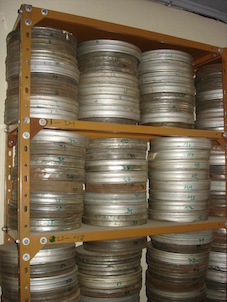
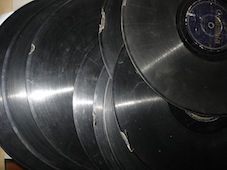
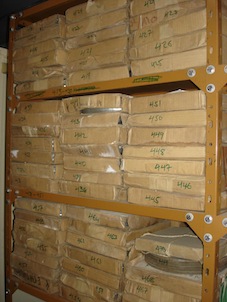
IES sound archives. Courtesy of Timkehet Teffera.
Glocal synergies and music archives
During
the last decennia, as intangible cultural heritage earned growing
interest among international scholars and culture professionals, Muslim
Ethiopian musical expressions increasingly raised the attention of
worldwide observers. Local communities and international organizations
incremented activities of documentation, preservation and valorization
of living heritage, while individual and cooperative researches
developed original approaches, methodologies and techniques in order to
properly identify, select, categorize, study and manage relevant musical
traditions.


|
3.19. VR - Gey weldo gey giba - Jaliyei - Gini Zebida .mp3 Size : 508.271 Kb Type : mp3 |
Graphic transcription of Jaliyei sung duet. Couplet "Gey waldo Gey Gibaa". Recording and transcription: IS 2006-2008.
The
2003 Convention for the Safeguarding of the Intangible Cultural
Heritage acted as a catalyst for a number of worldwide initiatives
connected with Ethiopian traditional musics, indeed including those of
Muslim cultural groups. In 2006, UNESCO launched a project in order
to enhance capacities for inventorying, recording, documenting and
archiving Ethiopian traditional musics; the attention to this domain of
living heritage was considered as particularly opportune since the
country is gradually opening up to modernity. Many regional and
national Ethiopian institutions were sensitive to this issue and
expressed their wish to contribute to the project. Besides the UNESCO
music project, a number of other project flourished in Ethiopia and
abroad with regard to ICH and involved documentation, creation of
archives, capacity building and knowledge transfer, distribution of
equipment and general cooperation between international parts.
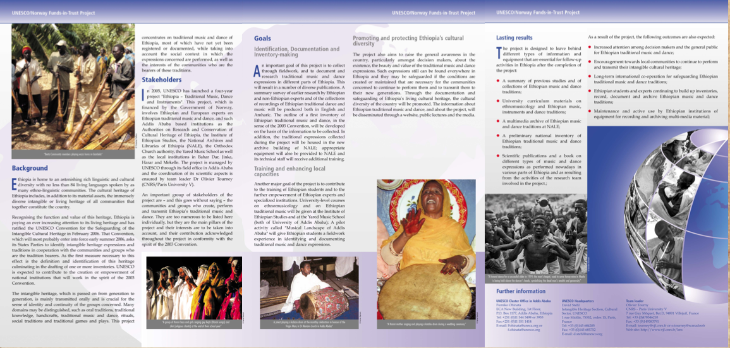
Brochure of the UNESCO project "Ethiopia - Traditional Music, Dance and Instruments"
The last few years also marked the flowering of Ethiopianist musical scholarship, with dozens of articles and books being published by Ethiopian and international scholars. It is worthwhile to notice the exponential proliferation of Ethiopian publications, both at an academic and a professional level, as a mirror of the development of local expertise. Academic as well as non-academic writings, films, audio and web publications were produced and increasingly broadcasted. Internet notably allowed community members to create an efficient transnational, transgenerational, transcultural, translinguistic network, to take part, to share music, to get in touch.
Presently, forces keep being joined in order to avoid the erosion of many expressions of intangible heritage, while a growing public is enjoying the exploration of until now barely known popular productions.
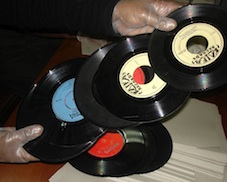
In this scenario, archives represent the most puzzling question.
Ethiopian Archives are increasingly growing, both quantitatively and
qualitatively. Unfortunately, they are often unaccessible -not only by the general
public, but also by specialists.
Although some initiatives have
been carried on towards proper cataloguing and conservation of audio
documents and supports, these are still quite poor compared to the
abundance of materials available.
Moreover, the attention given to the
recently collected recordings is often higher than the attention given
to the recordings collected, generally by Ethiopians, before the issues
of ICH preservation raised at an international level.
In order to
protect, valorize and and transmit musical, poetical, linguistic,
literary social and ritual traditions of Ethiopian Muslim it is
necessary to merge the knowledges and needs of local and international
communities and cultural institutions.
Archives

Click to access online archives
Sherif Harar City Museum - Samples from the sound archives
The Sherif Harar City museum audio collection represents an extremely important legacy.Harari people recorded their songs ever since the ‘50s; these recordings hold Harari people’s memory of repertoires (including extinct and disappearing ones) and provide a diachronic perspective on Harari intangible cultural heritage, which is just as remarkable as the tangible legacy of the city.
Here is a small description of the collection.
Materials: reel tapes (150/200), cassettes (300/400).
Content: Harari songs (including extinct practices as well as unique recordings of mugad songs); other expressions of local ICH (children plays, zikri, religious ceremonies); recordings of political meetings and radio programs; Quran recitations; songs from other Ethiopian groups and from other countries.
Dated: up to 55 years old.
Quality: very scarce, endangered by further playing.
A peculiar synergy between local and international forces is particularly evident in Harari music history and in the cultural relationships developed by Mr. Abdullahi Ali Sherif and his family.
The sound archives of the Sherif Harar city museum however still deserve adequate consideration - notably funds, equipment and experts to work on track division, identification, proper cataloguing of recordings and restoration of original materials. So far digitalization was partially realized by Accademia di Santa Cecilia and Ambassade de France en Ethiopie.
The collection is located in Harar within the museum. Part of it is available online through EverythingHarar website.
Click here
Harar Connection - History/Culture section
Includes texts of traditional wedding and children songs (amharic font) as well as a genealogic tree of Mugad bands.